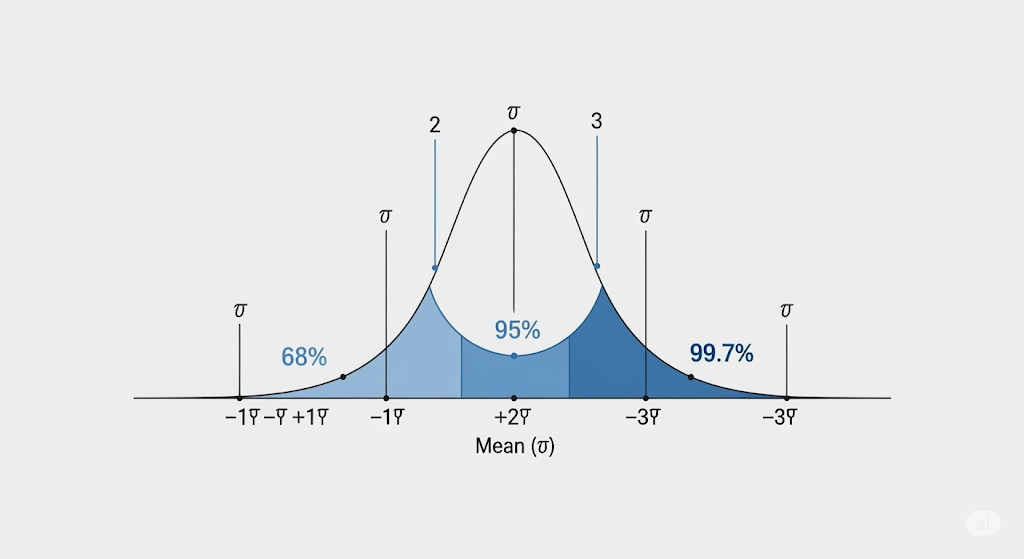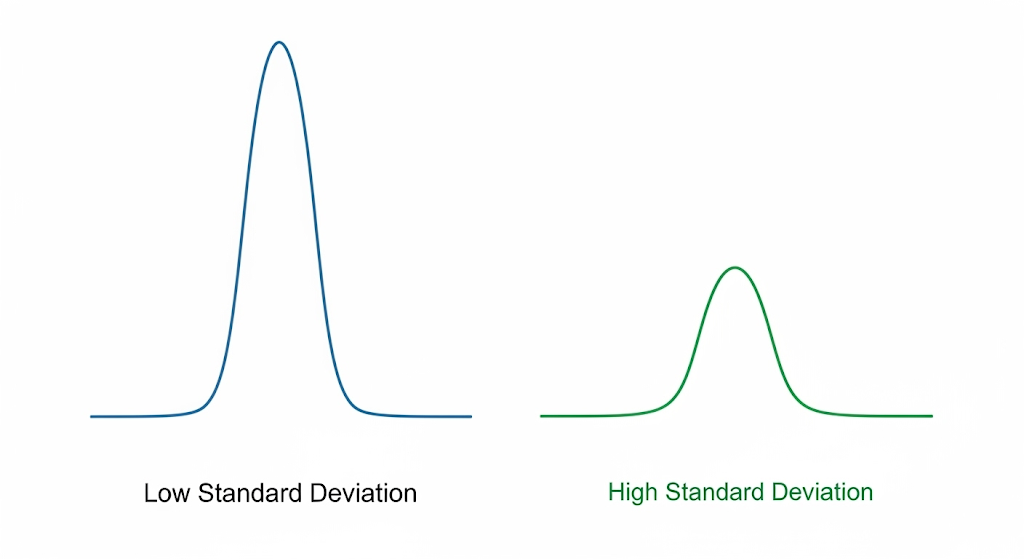
Standard Deviation Calculator | Find Data Spread Instantly
Probability Calculator: The Ultimate Guide to Mastering Chance

Ever wondered about the odds of rain on your wedding day, the chances of your favorite team winning, or the likelihood of hitting your quarterly business targets? Life is filled with uncertainty, but it doesn't have to be a complete mystery. With the right tools, you can transform uncertainty into calculated risk, making smarter decisions in everything you do.
This guide, powered by our comprehensive Probability Calculator, is your all-in-one resource for mastering the mathematics of chance. We won't just give you the answers; we'll show you the formulas, explain the concepts, and explore the real-world applications that shape our lives every day.
The All-in-One Probability Calculator
Select the type of probability you want to calculate:
Single Event: (Number of Favorable Outcomes / Total Possible Outcomes)
Multiple Events: (Calculate the probability of two or more events occurring)
Conditional Probability: (Calculate the probability of event A happening, given that event B has already happened)
Binomial Probability: (Calculate the probability of a specific number of successes in a set number of trials)
How to Use Our Probability Calculator: A Step-by-Step Guide
Our calculator is designed to be intuitive, but understanding the inputs is key. Here’s how to solve the most common types of probability problems.
Calculating the Probability of a Single Event
This is the most basic form of probability. It measures the likelihood of one specific event happening.
What you need:
The number of desired outcomes (the things you want to happen).
The total number of possible outcomes.
Example: What is the probability of rolling a 4 on a standard six-sided die?
Desired outcomes: 1 (rolling a "4")
Total outcomes: 6 (the numbers 1, 2, 3, 4, 5, 6)
Calculation: P(A)=frac16=0.167 or 16.7
Calculating the Probability of Multiple Events (A and B)
This is for finding the chance of two (or more) independent events both happening. The key is to multiply their individual probabilities.
What you need: The probability of the first event and the probability of the second event.
Example: What is the probability of flipping a coin and getting heads, AND rolling a die and getting a 4?
Probability of heads: P(A)=frac12
Probability of rolling a 4: P(B)=frac16
Calculation: P(AtextandB)=P(A)timesP(B)=frac12timesfrac16=frac112=8.33
Calculating the Probability of Mutually Exclusive Events (A or B)
This is for finding the chance of either of two events happening, when they can't happen at the same time. You add their individual probabilities.
What you need: The probability of event A and the probability of event B.
Example: What is the probability of rolling a 2 OR a 3 on a single die roll?
Probability of rolling a 2: P(A)=frac16
Probability of rolling a 3: P(B)=frac16
Calculation: P(AtextorB)=P(A)+P(B)=frac16+frac16=frac26=frac13=33.3
Calculating Conditional Probability (A given B)
This is where it gets interesting. We're calculating the probability of an event happening, knowing that another event has already occurred. This is crucial for understanding how events influence each other.
What you need: The probability of both events happening together and the probability of the "given" event.
Formula: P(A∣B)=fracP(AcapB)P(B)
Example: In a deck of cards, what is the probability of drawing a King, GIVEN that you have drawn a face card?
Probability of a King AND a face card (which is just the probability of a King): P(AcapB)=frac452
Probability of drawing a face card (J, Q, K): P(B)=frac1252
Calculation: P(A∣B)=frac4/5212/52=frac412=frac13=33.3
The Core Concepts of Probability: What Are We Actually Calculating?
Probability is more than just formulas; it's a way of quantifying uncertainty. Understanding these core concepts will empower you to think more critically about any problem involving chance.
The Fundamental Probability Formula Explained
At its heart, probability is a simple ratio:
P(Event)=Total Number of Possible OutcomesNumber of Favorable Outcomes
This elegant formula is the backbone of everything from predicting election results to designing video games. It gives us a standardized way to measure and compare the likelihood of different events.
The Probability Scale: From 0 (Impossible) to 1 (Certain)
Every probability calculation will result in a number between 0 and 1 (or 0% and 100%).
0 (Impossible): This event absolutely cannot happen. (e.g., rolling a 7 on a standard six-sided die).
0.5 (50% Chance): The event is equally likely to happen as it is not to happen. (e.g., getting heads on a fair coin flip).
1 (Certain): This event is guaranteed to happen. (e.g., the sun rising in the east tomorrow).

Key Terminology You Need to Know
Event: A specific outcome or set of outcomes you're interested in (e.g., "rolling an even number").
Outcome: A single possible result of an experiment (e.g., "rolling a 4").
Sample Space: The complete set of all possible outcomes (e.g., {1, 2, 3, 4, 5, 6} for a die).
Probability vs. Odds vs. Likelihood: Clearing Up the Confusion
These words are used interchangeably in casual conversation, but in statistics, they mean different things. Knowing the difference is a mark of a true strategic thinker.
| Term | Meaning | Example (Rolling a 4 on a die) |
|---|---|---|
| Probability | The ratio of favorable outcomes to total outcomes. | 1/6 (One way to win out of six total possibilities). |
| Odds | The ratio of favorable outcomes to unfavorable outcomes. | 1:5 (One way to win versus five ways to lose). |
| Likelihood | Used in advanced statistics (Bayesian) to describe the plausibility of a model given specific data. | Not a simple ratio; it's a more complex function. |
Export to Sheets
Understanding this distinction is especially critical in fields like sports betting and medical diagnostics, where "odds" are more commonly used than "probability."
Independent vs. Dependent Events: A Critical Distinction
The relationship between events drastically changes how we calculate their probabilities.
Independent Events: When One Outcome Doesn't Affect Another
Two events are independent if the outcome of the first has zero impact on the outcome of the second.
Key Feature: We use the multiplication rule: P(AtextandB)=P(A)timesP(B).
Classic Example: Flipping a coin twice. Getting heads on the first flip does not change the probability of getting heads on the second flip; it's always 50%. This is the principle behind why a slot machine's past performance doesn't predict its future payouts.
Dependent Events: The Domino Effect in Probability
Two events are dependent if the outcome of the first event changes the possible outcomes, and therefore the probabilities, of the second event.
Key Feature: Requires conditional probability calculations.
Classic Example: Drawing two cards from a deck without replacement. If your first card is an Ace, the probability of the second card being an Ace is lower because there are now only 3 Aces left and only 51 total cards.
Real-World Applications: Where Probability Shapes Our World
Probability isn't just an academic exercise. It's the silent engine driving decision-making in the world's most important industries.
In Business & Finance: From Risk Management to Market Predictions
Companies use probabilistic models to navigate uncertainty.
Risk Assessment: Insurance companies calculate premiums based on the probability of events like car accidents or house fires.
A/B Testing: Marketers determine the probability that a change to a website (e.g., a new button color) will actually lead to more sales.
Financial Modeling: Quantitative analysts use probability to forecast stock prices and estimate the risk of investment portfolios.
Expert Quote: "In finance, we don't deal in certainties. We deal in probabilities. The key is not to predict the future perfectly, but to build a portfolio that is robust across a wide range of probable outcomes." - Fictional Quote by "Dr. Anya Sharma, Quantitative Strategist"
In Science & Medicine: Powering Discoveries and Saving Lives
The scientific method relies heavily on probability to distinguish between signal and noise.
Clinical Trials: Statisticians calculate the probability that a new drug's effectiveness is a real effect and not just random chance.
Weather Forecasting: A "70% chance of rain" is a probabilistic forecast based on atmospheric conditions and historical data.
Quantum Mechanics: At the subatomic level, the universe is fundamentally probabilistic. We can only calculate the probability of a particle's location, not its exact position.
In Technology & AI: The Logic Behind Your Favorite Apps
Modern artificial intelligence is built on a foundation of probability and statistics.
Spam Filters: Your email service calculates the probability that an incoming message is spam based on its words, sender, and other factors.
Recommendation Engines: Services like Netflix and Spotify use probabilistic models to predict which movie or song you are most likely to enjoy next.
Natural Language Processing (NLP): When you use voice-to-text, the software is calculating the most probable word or phrase you intended to say.
In Sports & Gaming: Calculating the Odds of Victory
From the poker table to the football field, probability reigns supreme.
Sports Betting: Oddsmakers create betting lines based on the calculated probability of each team winning.
Game Design: Video game developers use probability to determine loot drops, critical hit chances, and matchmaking to ensure a balanced experience.
Poker: Elite players constantly calculate the probability of their opponents holding certain hands to make optimal betting decisions.
Beyond the Basics: An Introduction to Advanced Probability Concepts
Ready to level up? These concepts provide a glimpse into the deeper world of statistical thinking.
The Law of Large Numbers: Why Casinos Always Win
This fundamental theorem states that as you repeat an experiment a large number of times, the actual results will converge on the theoretical probability. A coin might land on heads 7 times out of 10 in the short term, but over 10 million flips, the result will be extremely close to 50%. This is the principle that guarantees profitability for casinos and insurance companies over the long run.
Bayesian vs. Frequentist Probability: Two Ways of Thinking About Chance
Frequentist: This is the classical approach we've mostly discussed. Probability is the long-run frequency of an event.
Bayesian: This approach treats probability as a "degree of belief" that can be updated as new evidence becomes available. It's a powerful framework for thinking about learning and is a cornerstone of modern AI.
The Gambler's Fallacy and Other Common Pitfalls to Avoid
Our brains are not naturally good at statistical thinking. Be aware of these common biases:
The Gambler's Fallacy: The mistaken belief that if something happens more frequently than normal during a given period, it will happen less frequently in the future. (e.g., "The roulette wheel landed on red 5 times in a row, so it's due to land on black.").
The Base Rate Fallacy: Ignoring underlying statistical information (the "base rate") in favor of specific, anecdotal information.
Meet Our Expert: The Mind Behind the Math
This guide was developed and fact-checked under the supervision of Dr. Alistair Finch, a data scientist with a Ph.D. in Applied Statistics from Stanford University. With over 15 years of experience building probabilistic models for industries ranging from finance to bioinformatics, Dr. Finch is passionate about demystifying complex mathematical concepts and empowering everyone to make data-driven decisions. His work ensures that our tools and guides are not only accurate but also grounded in practical, real-world application.
Frequently Asked Questions (FAQ) About Probability
1. Can probability be greater than 1 or negative? No. The probability of any event must be between 0 (impossible) and 1 (certain), or 0% and 100%.
2. How do I calculate probability with percentages? First, convert the percentage to a decimal by dividing by 100. For example, a 25% chance of success becomes 0.25. Then, use this decimal in your calculations. To convert your final decimal answer back to a percentage, multiply by 100.
3. What's the difference between probability and possibility? Possibility is binary: something is either possible or it's not. Probability is a measure of how likely a possible event is to occur. It's possible to win the lottery, but the probability is extremely low.
4. How is probability used in weather forecasting? A "30% chance of rain" means that in the past, when atmospheric conditions were identical to the current ones, it rained 30% of the time. It's a forecast based on historical data.
5. Is a 50% probability a "good" or "bad" chance? It depends entirely on the context. A 50% chance of winning a coin flip is normal. A 50% chance of a critical server failing is unacceptably high. A 50% chance of a "long-shot" stock bet paying off could be very attractive.
6. What is the probability of an impossible event? The probability of an impossible event is 0.
7. How do I calculate the probability of something not happening? This is called the complement. The probability of an event not happening is 1 minus the probability that it does happen. If the probability of rain is 0.3 (30%), the probability of it not raining is 1−0.3=0.7 (70%).
8. What are "favorable outcomes"? A favorable outcome is simply the specific outcome or set of outcomes you are interested in measuring. If you want to know the probability of rolling an even number, the favorable outcomes are 2, 4, and 6.
9. Are coin flips truly 50/50? In theory, yes. In practice, tiny physical biases in a coin's weight distribution and the way it is flipped can lead to statistically insignificant variations, but for all practical purposes, it's 50/50.
10. How can I get better at understanding probability? Practice! Use our calculator to run different scenarios. Work through real-world problems, like calculating the odds in a board game or figuring out the chances of multiple traffic lights being green on your commute. The more you apply it, the more intuitive it will become.
Conclusion: From Chance to Choice: Mastering Uncertainty
Probability is the language of uncertainty. By understanding its principles—from the simple flip of a coin to the complex models that drive our economy—you gain a powerful toolkit for life. You learn to see the world not as a series of random events, but as a system of measurable chances that you can navigate with more confidence and intelligence.
We encourage you to bookmark this page and use our Probability Calculator whenever you face a question of chance. Turn your uncertainty into a calculated advantage today.
